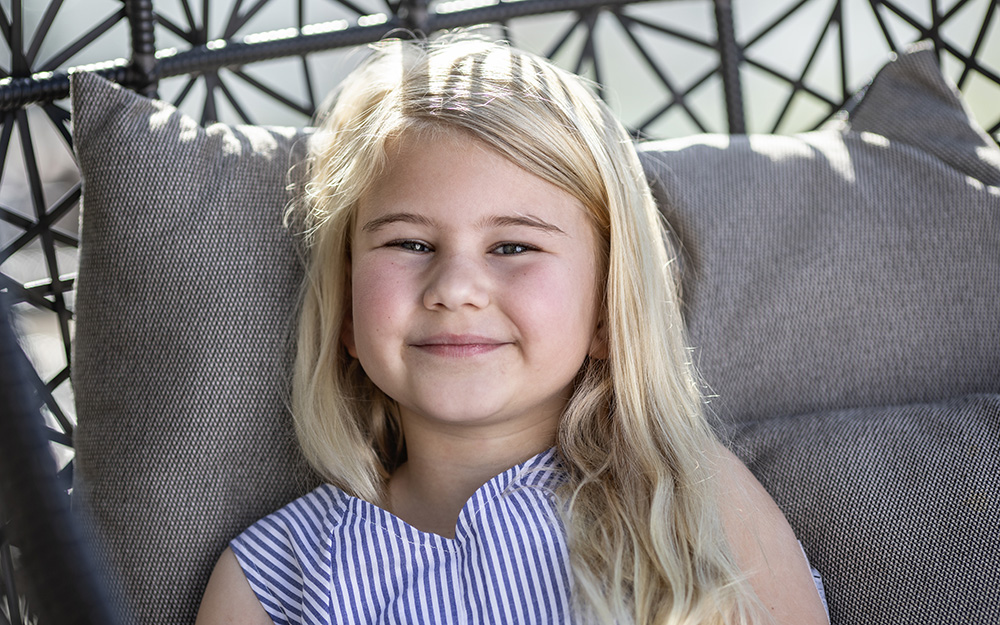Cedars-Sinai Blog
Tips for Parents of Kids with Diabetes
Jul 11, 2019 Cedars-Sinai Staff

Even though she’s only 7 years old, Shiloh Bearman is fully in control of her type 1 diabetes.
Amy and Ethan Bearman are not letting type 1 diabetes get in the way of their daughter Shiloh’s childhood or independence.
With Amy and Ethan’s guidance, 7-year-old Shiloh knows how to read and check her blood sugar levels, count carbohydrates, and use an automatic insulin pump.
"Shiloh is equipped to make a decision on how much insulin she needs. And that’s a good place for her and us—as parents—to be."
The insulin pump is a wireless device that gives Shiloh the freedom to monitor her glucose through a smartphone app and control her insulin while she’s at school, camp, or a sleepover.
"If for whatever reason there isn’t an adult around, Shiloh is equipped to make a decision on how much insulin she needs," says Amy. "And that’s a good place for her and us—as parents—to be."
Patients without an insulin pump typically monitor blood sugar levels manually by pricking their finger and placing a drop of blood on a test strip multiple times per day.
Without proper care, diabetes can cause a series of long-term health problems that affect the eyes, kidneys, heart, brain, feet, and nerves.
The potential for serious complications is one of the reasons Amy and Ethan have been proactive in educating Shiloh about managing her diabetes. And why they want to share what they’ve learned with other parents.
Amy and Ethan’s tips for parents of diabetic children
Connect with others
Amy and Ethan say there was a lot to take in when they found out Shiloh had diabetes.
Connecting with another family whose child has diabetes made it less overwhelming and provided a support circle, stress reduction, and a wealth of information about the different ways to approach treatment.
Trust others
The Bearmans avoid the attitude that diabetes is "too difficult to explain."
Instead they focus on making sure caregivers are familiar with Shiloh’s needs, treatment, and what to do in case of an emergency.
Once they educate a family member, teacher, or babysitter about diabetes, Amy and Ethan say it’s easy to trust them. Being comfortable with other people caring for their child creates freedom for everyone.
Involve siblings
When Shiloh was first diagnosed with diabetes, her older brother Levi would find clever ways to check her blood sugar levels. He’d say "Look at that butterfly!" and when she turned her head, he’d poke her finger so quickly she wouldn’t feel a thing.
Amy and Ethan say teaching Levi how to care for Shiloh brought them closer together and gave him responsibility.
In the Newsroom: Type 1 Diabetes Doesn’t Take a Summer Break
Embrace technology
Shiloh was only a month into her diagnosis when Amy and Ethan decided to try an insulin pump to make managing the disease as easy as possible—for them and for Shiloh.
The insulin pump eliminates manual injections and finger pricks. "And it’s waterproof, so Shiloh can go swimming for as long as she wants," says Amy.
Keep a positive attitude
"Having type 1 diabetes does not define Shiloh," says Ethan.
Even though diabetes is a disease, Amy and Ethan refer to it as a situation, a condition, or a set of circumstances. They avoid asking, "Why Shiloh?" or thinking of their family as unlucky.
They say this positive mindset allows them to look for ways their family can learn, grow, and give back. "There are so many good things that are hidden in challenges and it’s important to find those," says Amy.
Shiloh has her own advice for other kids with diabetes: Don’t let diabetes get in the way of your future.
"I want to be an actress," she says. "In the movies or television shows."

The whole Bearman family supports Shiloh in managing and treating her diabetes.


